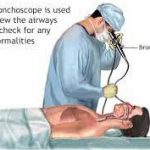
Bronchoscopy helps doctors to look at the lungs and airways. It is a procedure used to examine the airways and lungs using a flexible tube with a light and camera attached to it. A pulmonologist (lung specialist) or surgeon passes a thin tube through the nose or mouth, down the throat, into the lungs. They often take biopsy (small piece) of any abnormal looking areas.
Why is a bronchoscopy done?
- Diagnose lung problem such as infection or cancer
- Remove mucus, foreign bodies, tumor, or other blockages in the airways or lungs
- Treat lung problems such as bleeding, an abnormal narrowing of the airway due to cancer or other reasons
What special precautions to be taken?
Before the procedure
The doctor should know about your allergies and medicines you are taking, including vitamins, herbs, supplements. Ask your Doctor if you need to stop taking blood-thinning medication several days before the test. Avoid eating or drinking anything for several hours before the procedure.
During the procedure
Bronchoscopy is usually an outpatient procedure (no need to stay overnight in a hospital).
You should lie down on a bed, with your head raised slightly. The doctor will spray your mouth, nose, and throat with numbing medicine. The nurse will give some medicines through a vein (IV) for relaxation. You will be under general anesthesia.
The procedure might make you cough if you are awake. Bronchoscopy takes about 25-30 minutes. It might take longer, depending on the complexity of the procedure.
After the procedure
You will be under observation to monitor complications. After the procedure, you may have a sore throat, cough, hoarseness, numbness in the mouth, and throat for a couple of hours. Don’t eat or drink until the numbness goes away.
The doctor will instruct you on what to do and what to avoid. Sometimes biopsies are performed as a part of the procedure. You must follow up with your healthcare team after the procedure.
What are the risks and complications of bronchoscopy?
Complications from bronchoscopy are uncommon, minor, and rarely severe. It includes inflamed or damaged airways due to disease. Complications may arise due to the procedure, anesthesia, or topical numbing medicines.
- Bleeding: It may occur after a biopsy. Usually, it is minor and stops without treatment.
- Collapsed lung: In rare cases, an airway may get injured during bronchoscopy. If the lung is punctured, air can collect in the space around the lung. It causes the lung to collapse. It is curable but may require a hospital stay.
- Fever: It is common after bronchoscopy but is not always a sign of infection.
- Allergic reaction: Rarely, bronchoscopy can cause an allergic reaction to medications used during the procedure or the cleaning solutions used to sterilize the equipment.
- Breathing problems: During bronchoscopy, the tube can cause temporary irritation and inflammation in the airways, which may lead to coughing, wheezing, or shortness of breath.
- Cardiac arrhythmia: In rare cases, bronchoscopy can trigger abnormal heart rhythms in people with underlying heart conditions.
- Vocal cord injury: The bronchoscope can cause temporary or permanent damage to the vocal cords, which can affect voice quality and speech.
When to seek medical help?
Call the doctor if you have:
- High fever
- Severe chest pain
- Difficulty breathing
- Blood in cough
How can Ankr help you for bronchoscopy?
Don’t try to go alone for the bronchoscopy. Use Ankr to:
(1) learn about the common procedure and associated symptoms
(2) send message to your Doctor if they use Ankr platform*
(3) be better informed about how to prevent risks and complications
